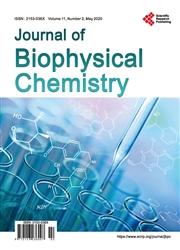Spin nature of genetic code
引用次数: 2
Abstract
Nature has developed codon as a tool to manipulate a two-electron spin symmetry (short-living electrons, forming a radical pair, arise from the Mg-bound nucleosidetriphosphate cleavage at the triplet/singlet (T/S) crossing), which permits or forbids further nucleotide synthesis (DNA/RNA) and the synthesis of proteins. The thesis is confirmed by conducting DFT:B3LYP (6-311G** basis set) computations (T/S potential energy surfaces) with the model system composed of the template (C-G-C-G-A nucleotide sequence) and the growing chain (G-C-G nucleotide sequence, DNA or RNA). The origin of codon is in hyperfine interaction between a single electron, transferred onto the template, and three 31P nuclei built into the phosphorus fragments of nucleotides. The nuclei, together with the polynucleotide structure, form a spiral twist that is homeomorphic to a triangle patch on the Poincare sphere. Each triangle has unique angle values depending on the nucleotide nature and their position in the codon. The patch tracing produces the Berry phase changing the electron spin orientation from “up” to “down”. The Berry phase accumulation proceeds around the (T/S) conical intersections (CIs). The CIs are a result of complementary recognition between nucleotide bases at distances exceeding the commonly accepted Watson-Crick pairing by 0.17 A. Upon changing spin symmetry, the DNA or RNA chain is allowed to elongate by attaching a newly coming nucleotide. Without complementary recognition between the bases, the chain stops its elongation. The Berry phase accumulation along the patch tracing explains the effect of Crick’s wobbling when the second nucleotide plays a primary role in recognition. The data is directly linked to creation of a quantum computing device.遗传密码的自旋性质
大自然已经开发出密码子作为操纵双电子自旋对称的工具(短寿命电子,形成自由基对,由镁结合的核苷三磷酸在三重态/单线态(T/S)交叉时裂解产生),这允许或禁止进一步的核苷酸合成(DNA/RNA)和蛋白质合成。通过模板(C-G-C-G-A核苷酸序列)和生长链(G-C-G核苷酸序列,DNA或RNA)组成的模型体系进行DFT:B3LYP (6-311G**基集)计算(T/S势能面)来证实本文的结论。密码子的起源是转移到模板上的单个电子与核苷酸磷片段中的三个31P核之间的超精细相互作用。原子核与多核苷酸结构一起,形成一个螺旋状的扭曲,与庞加莱球上的三角形斑块同胚。每个三角形都有独特的角度值,这取决于核苷酸的性质和它们在密码子中的位置。贴片示踪产生贝里相,使电子自旋方向由“上”变为“下”。在(T/S)锥形交点(CIs)周围进行Berry相积累。CIs是核苷酸碱基之间的互补识别的结果,距离比普遍接受的沃森-克里克配对距离高出0.17 a。当自旋对称发生改变时,DNA或RNA链可以通过连接一个新加入的核苷酸而被拉长。如果碱基之间没有互补识别,链就会停止延伸。当第二个核苷酸在识别中起主要作用时,沿着贴片追踪的贝里相积累解释了克里克摆动的影响。这些数据与量子计算设备的创建直接相关。
本文章由计算机程序翻译,如有差异,请以英文原文为准。
求助全文
约1分钟内获得全文
求助全文

 求助内容:
求助内容: 应助结果提醒方式:
应助结果提醒方式:


